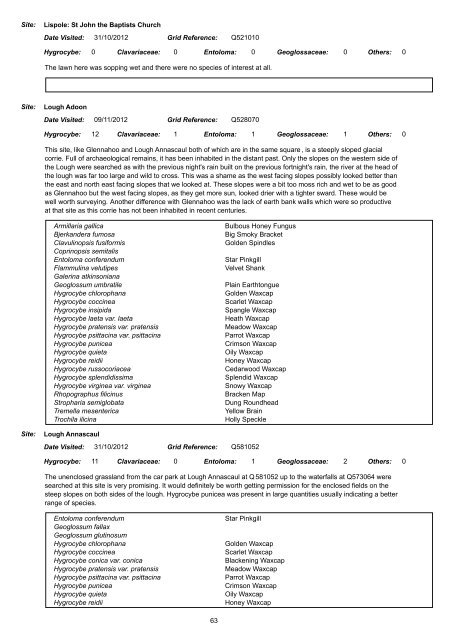North Kerry Waxcap Survey 2012 - the Northern Ireland Fungus Group
North Kerry Waxcap Survey 2012 - the Northern Ireland Fungus Group
North Kerry Waxcap Survey 2012 - the Northern Ireland Fungus Group
You also want an ePaper? Increase the reach of your titles
YUMPU automatically turns print PDFs into web optimized ePapers that Google loves.
Site: Lispole: St John <strong>the</strong> Baptists Church<br />
Date Visited: 31/10/<strong>2012</strong><br />
Grid Reference: Q521010<br />
Hygrocybe:<br />
0<br />
Clavariaceae:<br />
0<br />
Entoloma:<br />
The lawn here was sopping wet and <strong>the</strong>re were no species of interest at all.<br />
Site: Lough Adoon<br />
Date Visited: 09/11/<strong>2012</strong><br />
Grid Reference: Q528070<br />
Hygrocybe:<br />
12<br />
Clavariaceae:<br />
1<br />
Entoloma:<br />
0<br />
1<br />
Geoglossaceae:<br />
Geoglossaceae:<br />
0<br />
1<br />
O<strong>the</strong>rs: 0<br />
O<strong>the</strong>rs: 0<br />
This site, like Glennahoo and Lough Annascaul both of which are in <strong>the</strong> same square , is a steeply sloped glacial<br />
corrie. Full of archaeological remains, it has been inhabited in <strong>the</strong> distant past. Only <strong>the</strong> slopes on <strong>the</strong> western side of<br />
<strong>the</strong> Lough were searched as with <strong>the</strong> previous night's rain built on <strong>the</strong> previous fortnight's rain, <strong>the</strong> river at <strong>the</strong> head of<br />
<strong>the</strong> lough was far too large and wild to cross. This was a shame as <strong>the</strong> west facing slopes possibly looked better than<br />
<strong>the</strong> east and north east facing slopes that we looked at. These slopes were a bit too moss rich and wet to be as good<br />
as Glennahoo but <strong>the</strong> west facing slopes, as <strong>the</strong>y get more sun, looked drier with a tighter sward. These would be<br />
well worth surveying. Ano<strong>the</strong>r difference with Glennahoo was <strong>the</strong> lack of earth bank walls which were so productive<br />
at that site as this corrie has not been inhabited in recent centuries.<br />
Armillaria gallica Bulbous Honey <strong>Fungus</strong><br />
Bjerkandera fumosa Big Smoky Bracket<br />
Clavulinopsis fusiformis Golden Spindles<br />
Coprinopsis semitalis<br />
Entoloma conferendum Star Pinkgill<br />
Flammulina velutipes Velvet Shank<br />
Galerina atkinsoniana<br />
Geoglossum umbratile Plain Earthtongue<br />
Hygrocybe chlorophana Golden <strong>Waxcap</strong><br />
Hygrocybe coccinea Scarlet <strong>Waxcap</strong><br />
Hygrocybe insipida Spangle <strong>Waxcap</strong><br />
Hygrocybe laeta var. laeta Heath <strong>Waxcap</strong><br />
Hygrocybe pratensis var. pratensis Meadow <strong>Waxcap</strong><br />
Hygrocybe psittacina var. psittacina Parrot <strong>Waxcap</strong><br />
Hygrocybe punicea Crimson <strong>Waxcap</strong><br />
Hygrocybe quieta Oily <strong>Waxcap</strong><br />
Hygrocybe reidii Honey <strong>Waxcap</strong><br />
Hygrocybe russocoriacea Cedarwood <strong>Waxcap</strong><br />
Hygrocybe splendidissima Splendid <strong>Waxcap</strong><br />
Hygrocybe virginea var. virginea Snowy <strong>Waxcap</strong><br />
Rhopographus filicinus Bracken Map<br />
Stropharia semiglobata Dung Roundhead<br />
Tremella mesenterica Yellow Brain<br />
Trochila ilicina Holly Speckle<br />
Site: Lough Annascaul<br />
Date Visited: 31/10/<strong>2012</strong><br />
Grid Reference: Q581052<br />
Hygrocybe:<br />
11<br />
Clavariaceae:<br />
0<br />
Entoloma:<br />
1<br />
Geoglossaceae:<br />
2<br />
O<strong>the</strong>rs: 0<br />
The unenclosed grassland from <strong>the</strong> car park at Lough Annascaul at Q 581052 up to <strong>the</strong> waterfalls at Q573064 were<br />
searched at this site is very promising. It would definitely be worth getting permission for <strong>the</strong> enclosed fields on <strong>the</strong><br />
steep slopes on both sides of <strong>the</strong> lough. Hygrocybe punicea was present in large quantities usually indicating a better<br />
range of species.<br />
Entoloma conferendum Star Pinkgill<br />
Geoglossum fallax<br />
Geoglossum glutinosum<br />
Hygrocybe chlorophana Golden <strong>Waxcap</strong><br />
Hygrocybe coccinea Scarlet <strong>Waxcap</strong><br />
Hygrocybe conica var. conica Blackening <strong>Waxcap</strong><br />
Hygrocybe pratensis var. pratensis Meadow <strong>Waxcap</strong><br />
Hygrocybe psittacina var. psittacina Parrot <strong>Waxcap</strong><br />
Hygrocybe punicea Crimson <strong>Waxcap</strong><br />
Hygrocybe quieta Oily <strong>Waxcap</strong><br />
Hygrocybe reidii Honey <strong>Waxcap</strong><br />
63


